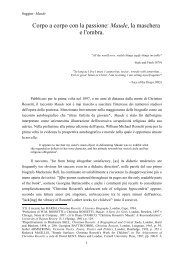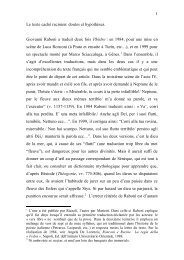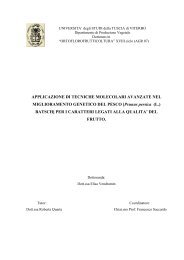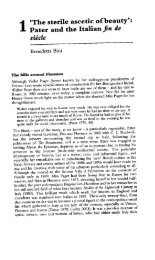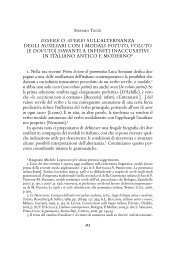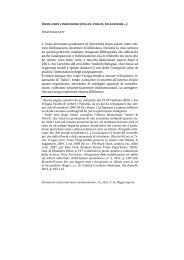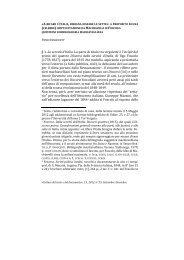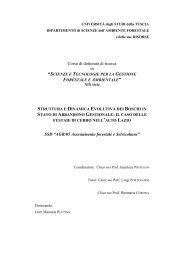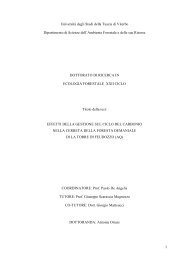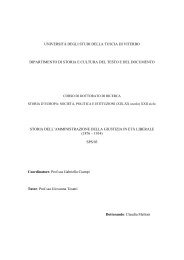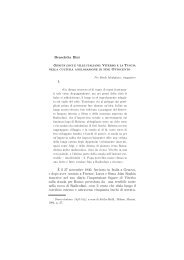drivers of soil respiration of root and microbial ... - Unitus DSpace
drivers of soil respiration of root and microbial ... - Unitus DSpace
drivers of soil respiration of root and microbial ... - Unitus DSpace
Create successful ePaper yourself
Turn your PDF publications into a flip-book with our unique Google optimized e-Paper software.
3.2.2. In situ pulse labeling procedure <strong>and</strong> gas sampling<br />
Pulse labeling was performed in the first days <strong>of</strong> June 2008.<br />
70<br />
1. Three labeling zones <strong>of</strong> 60cm 2 were established on the study site two months prior to the<br />
labeling procedure. Inside each zone two PVC collars (Ø20cm) were inserted to the <strong>soil</strong>.<br />
One <strong>of</strong> the collar was placed on the planted <strong>soil</strong> (total <strong>respiration</strong>, Rtot) <strong>and</strong> another one - on<br />
the bare <strong>soil</strong> with previously clipped plants (belowground <strong>respiration</strong>, Rb).<br />
2. A Plexiglas labeling chamber (LC) was designed <strong>and</strong> constructed (Fig. 1 <strong>and</strong> 2) in the<br />
laboratory <strong>of</strong> forest ecology, University <strong>of</strong> Tuscia. LC was placed on <strong>soil</strong> to cover the<br />
chosen labeling zones. Air was circulating between LC <strong>and</strong> an infrared gas analyzer<br />
(CIRAS DC, PP-System, UK) using its internal pump at a constant rate. Some <strong>of</strong> the<br />
circulating gas stream was by-passing the IRGA by the use <strong>of</strong> adjacent pump, connected to<br />
the column with soda-lime for CO2 scrubbing.<br />
3. A labeling solution (Na2 13 CO3) was placed in 100 ml jar <strong>and</strong> sealed with a lid containing<br />
two valves <strong>and</strong> a septum port. Plastic tubes were connecting the jar to the IRGA-soda lime<br />
system, in the entrance <strong>of</strong> it to LC. A 5M lactic acid was introduced to the jar through the<br />
septum port with a syringe, after that the valve on the lid was opened letting the label to<br />
enter the LC. To each LC was introduced 350 mg <strong>of</strong> the Na2 13 CO3.<br />
4. To stimulate the photosynthesis when the 13 CO2 was assimilated an additional unlabeled<br />
pure CO2 was released (by acidifying Na2CO3) into LC, keeping the level <strong>of</strong> CO2 in the<br />
chamber close to the ambient by regulating the rate <strong>of</strong> the flow <strong>of</strong> gas through soda-lime.<br />
The hole labeling procedure took 1 h.<br />
5. After the opening <strong>of</strong> LC was started the trapping <strong>of</strong> recently assimilated CO2 from the PVC<br />
collars: each collar was sealed with a lid for 1 hour (Fig. 3). Each chamber headspace was<br />
connected through a valve to a 2L flask, which previously had been evacuated to a high<br />
vacuum. A 2L vacuum flask were collected after 1 hour <strong>of</strong> CO2 accumulation in the<br />
chamber space. After that the lid <strong>of</strong> the PVC chambers remained open, up to the next<br />
accumulation. A 2L flask from bare plot was collected before the pulse labeling to estimate<br />
the<br />
13 C-CO2. background signal. Gas sampling was performed ten times during the chase<br />
period which lasted ten days. The timing <strong>of</strong> the sampling was the following: 1h-2h-4h-10h-<br />
16h-24h-35h-48h-96h-240h.<br />
6. Along with the pulse labeling, measurements <strong>of</strong> <strong>soil</strong> <strong>respiration</strong> from mesh bags which were<br />
installed previously to separate heterotrophic <strong>and</strong> autotrophic <strong>respiration</strong> were performed.<br />
Both time lags, obtained with 13 C labeling <strong>and</strong> meshes experiment were confronted.




